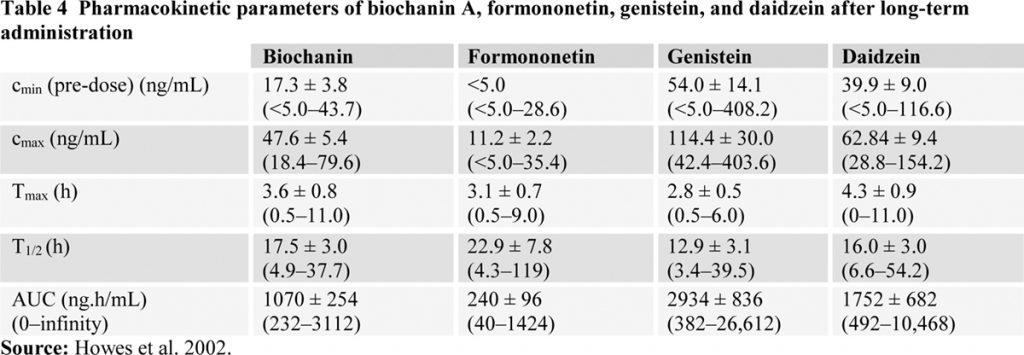Pharmacokinetics
Pharmacokinetic studies have been carried out with isoflavones from soy existing as β-glycosides (bound to sugar) and red clover isoflavones existing as aglycones (free from sugar). These showed that the isoflavones from the red clover were absorbed much faster than the isoflavone glycosides from soy.
In one study (Setchell KD et al., 2001), 15 healthy women were given 50 mg each of daidzein, genistein and their associated β-glycosides. Blood samples were taken and analyzed 24 hours after red clover was administered.
The data showed that the time to reach the maximum plasma concentration (Tmax) depends on whether isoflavones exist as aglycones or glycosides. The Tmax for the aglycones was 4–7 hours, while it was 8–11 hours for the isoflavones that were bound to sugar. The reason is that the sugar must first be cleaved off in the intestine before it can be absorbed.
In another study (Setchell KD et al., 2002), the study participants were given a single 40 mg dose of red clover isoflavones, primarily in the form of formononetin and biochanin A as aglycones, as well as a smaller quantity of daidzein and genistein. HPLC analyses of the blood samples showed that there was a rapid increase in the plasma concentration of daidzein and genistein, the proportion of which was more than 95% of the measured isoflavones. This confirmed that formononetin and biochanin A are demethylated to daidzein and genistein.
In a subsequent study (Howes J et al., 2002), 14 subjects were given 80 mg of red clover isoflavones over 14 days. In comparison to their metabolites daidzein and genistein, lower concentrations of biochanin A and formomentin were detected in the plasma. Here too, it could be deduced that formononetin and biochanin A are demethylated to daidzein and genistein. The AUC for genistein was greater than for daidzein – approximately 2934 ng.h/mL in comparison to 1752 ng.h/mL. The half-life of genistein was 13 hours while that of daidzein was 16 hours.
Isoflavones are metabolized in the intestine, absorbed, conjugated in the liver and excreted with the urine. The metabolites often have a higher level of activity than their original substance, e.g. equol, though this is very individual and can be generated only by people who are termed “equol producers” (approx. 30%–50% of individuals) (Watanabe S et al., 1998; Atkinson C et al., 2005; Cassidy A et al., 1994; Cassidy A et al.,1995; Akaza H et al., 2002; Kelly GE et al., 1995; Rowland IR et al., 2000).
Bioavailibility
The results of the Lipovac M et al. (2015) study showed that the predominant isoflavones in MF11RCE®, biochanin A and formononetin, reached the maximum concentration after 5 to 7 hours.
This was comparable with the Tmax values for the isoflavones that are predominant in soy – genistein and daidzein. Formononetin was rapidly and predominantly demethylated to daidzein. The serum concentration of daidzein increased quickly following administration of the red clover isoflavones. Daidzein from red clover had a higher Tmax value than the glycosides of the soy isoflavones, as had already been ascertained by Setchell KD et al. (2001).
These results confirm that a once-daily dose of 80 mg MF11RCE® results in a sufficient and constant blood level.
Red clover isoflavone metabolite bioavailability is decreased after fructooligosaccharide supplementation
M. Lipovac, A. Pfitscher, S. Hobiger, T. Laschitz, M. Imhof, P. Chedraui, A. Jungbauer

